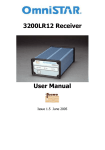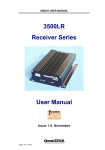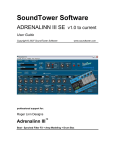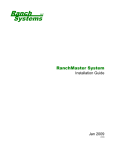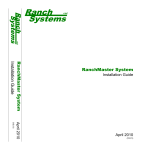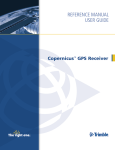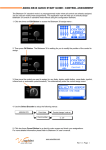Download OmniLite 132 Receiver User Manual
Transcript
OmniLite 132 RECEIVER USER MANUAL OmniLite 132 Receiver User Manual Issue 1.3 November 2001 Issue 1.3 11/01 OmniLite 132 RECEIVER USER MANUAL Notice to Customers This manual has been produced to ensure the very best performance from your OmniSTAR receiver. The manual has been clearly set out with simple instructions to ensure trouble free usage of your OmniSTAR receiver. This publication could contain technical inaccuracies or typographical errors. Changes are periodically made to the information herein; these changes will be incorporated in new editions of this publication. Should you require further assistance please contact your local dealer or the OmniSTAR Perth office. OmniSTAR Customer Support and 24 Hour Help Line OmniSTAR Pty Ltd 18 Prowse Street West Perth 6005 Western Australia Contact Numbers: Office: Network Control Centre (NCC) - 24hours: Freecall – 24 hours: (08) 9322 5295 (08) 9321 0284 1800 062 221 Fax Numbers: Office: Network Control Centre: (08) 9322 4164 (08) 9321 0885 World Wide Web Internet Address: Email address: Issue 1.3 11/01 www.omnistar.com.au [email protected] i OmniLite 132 RECEIVER USER MANUAL Dealer Information Name ___________________________________ Address ___________________________________ City ___________________________________ State ___________________________________ Post Code ___________________________________ Country ___________________________________ Phone ___________________________________ Fax ___________________________________ Email ___________________________________ Issue 1.3 11/01 ii OmniLite 132 RECEIVER USER MANUAL One-Year Limited Hardware Warranty OmniSTAR Pty Ltd and its operating companies world-wide (OmniSTAR), warrants this product to be free from defects in workmanship and material for a period of one year from the date of original sale by OmniSTAR or its authorised dealers, to the original purchaser or end user. OmniSTAR reserves the right to repair and/or replace, at its option, any part or parts found to be defective, provided such defects, in their opinion, are due to faulty material or workmanship and are not caused by unauthorised or improper repair or abuse, or normal wear. Purchaser shall be responsible for shipping and insurance of the returned product for repair under this warranty. OmniSTAR will pay shipping and insurance for the product's return to purchaser provided that the product returned proves to be defective under this limited warranty. This warranty applies only to normal usage of the product. It does not apply to units or electronic circuit boards defective due to improper installation or handling. Physical damage due to lightning or other electrical discharge and units subjected to fresh or salt water contamination is not covered. OmniSTAR reserves the right not to warrant the product if, upon request, sufficient proof of recommended installation compliance as laid out in this manual is not provided. No other warranties are expressed or implied. No other warranties exist. OmniSTAR assumes no responsibility for any consequential or incidental losses or damages of any nature with respect to the use of this product. REVISION HISTORY Issue 1.0 September 1999 Issue 1.1 January 2000 Issue 1.2 September 2001 Issue 1.3 November 2001 First Draft Amendments to text and layout Minor Changes Minor Changes Manual Reference: OmniLite Manual Copyright OmniSTAR Pty Ltd 1999. No part of this manual can be reproduced without the express permission of OmniSTAR Pty Ltd. Issue 1.3 11/01 iii OmniLite 132 RECEIVER USER MANUAL TABLE OF CONTENTS Introduction ..............................................................................................................1 Getting Started .........................................................................................................2 Initial Setup.......................................................................................................2 Interfacing.................................................................................................................4 Electrical Interface Description .........................................................................4 Power Requirements ........................................................................................5 Mechanical Interface.........................................................................................5 Interfacing with the OmniLite Receiver .............................................................5 Cables ..............................................................................................................6 LED Indicators..........................................................................................................7 Installation ................................................................................................................8 Installation Consideration..................................................................................8 Electrical Grounding Requirements ..................................................................8 Counter Electromagnetic Force (CEMF) ..........................................................8 Cable Installation Considerations......................................................................9 Antenna Location..............................................................................................9 APPENDIX A............................................................................................................10 Receiver Service Procedure ...........................................................................10 APPENDIX B............................................................................................................11 OmniSTAR Receiver Problem Report Form...................................................11 APPENDIX C ...........................................................................................................12 OmniLite 132 - Technical Specifications ........................................................12 User Notes ..............................................................................................................14 Issue 1.3 11/01 iv OmniLite 132 RECEIVER USER MANUAL Introduction The OmniLite 132 receiver consists of both 12-channel GPS receiver and L-Band differential receiver built into a single unit. It provides differentially corrected positions at various hertz rates through two independently configurable RS-232 I/O ports. Position accuracy is typically less than one metre and the receiver is suitable for both ground and air applications. Three LED indicator lights give operational status at a quick glance. The receiver can have a one-pulse-per-second output signal synchronised to GPS time. The OmniLite receiver is easily configured using TSIP commands. Baud rate, position update rate, common NMEA string output and binary data output are among the variables which can be controlled using the TSIP commands. More detail on these commands is provided in a later section. Issue 1.3 11/01 1 OmniLite 132 RECEIVER USER MANUAL Getting Started The purpose of this section is to get you started with the OmniLite 132 as quickly as possible. The guide will address receiving the satellite data carrier, and then checking the functionality of the internal GPS engine fitted. Generally when the receiver is supplied to you it will be configured for the mode and data link(s) you have subscribed to. In most cases to get up and running will be a case of connecting the appropriate cables and applying power to the system. Bare Rear View of OmniLite Receiver Initial Setup Steps 1 through 7 pertain to all OmniSTAR receiver models. 1. Refer to the following as you will need to assemble all the required items. • • • • • • OmniSTAR Receiver Antenna Antenna Cable Power Cable Data Port Cable Power Supply 2. Connect the power cable to a suitable 10 V – 32vDC power supply being sure to check correct polarity. Red – Positive vDC Black – Negative vDC Issue 1.3 11/01 2 OmniLite 132 RECEIVER USER MANUAL 3. The OmniLite 132 is an integrated GPS, DGPS receiver and needs only one antenna. You need to install the antenna where it has a clear 360° unobstructed view of the sky through an elevation of 10° through 90°. 4. Connect the antenna cable between the antenna and the TNC connector on rear pane. 5. Ensure the OmniSTAR power is OFF then connect the power cable into the power socket on the receiver. 6. Turn on the OmniLite and the Power LED will illuminate. Data LED’s will illuminate when Data is present in the respective Data ports. 7. The GGA output message will indicate a non-corrected stand alone position with a 1 (one) after the ‘E’ in the message when viewed on a suitable data logging device or computer. A differentially corrected position is indicated by a 2 (two) directly after the ‘E’ in the GGA message from Port A. Issue 1.3 11/01 3 OmniLite 132 RECEIVER USER MANUAL Interfacing Electrical Interface Description The RF Connector is a standard TNC 50 Ohm female connector. There are 10vDC present when the unit is powered up to bias the LNA in the remote antenna. Care should be taken not to connect or disconnect the antenna while powered up. The I/O cable connector is a standard DB 9 connector. The pin-out is defined below. Pin No 1 2 3 4 5 6 7 8 9 Name Not Connected Transmit Receive Ground Not Connected Not Connected Not Connected Not Connected Description N/A N/A N/A N/A N/A N/A This is the pin assignment for the OmniLite 132 communication ports. The connector type is a 9-pin female ‘D’ type. 1 2 3 4 5 6 7 8 9 PORT A (DCE) CANL_B TXDB* RXDB* PPS GND* EVENT CTSB/422B In RTSB/422B Out CANH_B 1 2 3 4 5 6 7 8 9 PORT B (DCE) CANL_A TXDA* RXDA* GND* RTSA CTSA CANH_A *Indicates standard cable connections. Warning: Do not use standard RS 232 cables as all connections will be made to the computer and there are non standard assignations on the pins of both ports. Use the provided Data Cables. Issue 1.3 11/01 4 OmniLite 132 RECEIVER USER MANUAL Power Requirements The unit will operate on any DC Voltage between 10 V and 32vDC without interruption. When operational, the unit dissipates 7 W of power. The OmniLite 132 can also withstand voltage surges up to 85 V. The input has reverse polarity protection, however as the negative terminal pin is also attached to the housing ground, large currents may flow to any ground attachments made to the housing. Reverse polarity must therefore be avoided to prevent damage to the vehicle supply. At Voltages below 10 Volts the unit will reset itself to prevent any data loss. At Voltages below 8.5 Volts the receiver will turn off. Mechanical Interface Mounting of the receiver is done with a mounting brace or brackets. Interfacing with the OmniLite Receiver The standard configuration is: Port A: 4 string NMEA @ 1 Hz, 9600 Baud (GGA, GSA, VTG, ZDA) Port B: TSIP Binary @ 1 Hz, 9,600 Baud 8-O-1 The default configuration is: The receiver will default to the below settings if the OmniLite 132 is reset to defaults. Port A: NMEA @ 9,600 8-N-1 Port B: TSIP @ 9,600 8-O-1 The OmniLite 132 Receiver has two fully configurable RS-232 serial ports. Commands may be issued on either port and the receiver may be configured to output any of the available messages on either port. The baud rate on each port is adjustable, however the data bits, parity and stop bits are set to 8-0-1 for TSIP, Port B and may not be changed. Issue 1.3 11/01 5 OmniLite 132 RECEIVER USER MANUAL Cables The OmniLite 132 is supplied with three cables. ANTENNA CABLE N/A 5 metre low loss RG58 Double shielding or equivalent TNC Male N Type Male GPS/DGPS Signal GPS/DGPS Signal N/A DATA CABLE DB9 Male DB9 Female -2m- 2 2 3 3 5 5 POWER CABLE 2metre Black Jacket Red & Black 2 Core Cable Pin # Wire colour 1 Positive DC Voltage Red 2 Negative DC Voltage Black 3 Not connected Pin 2 Pin 1 Pin 3 Mating end of Female Connector. Switchcraft EN3C3F Issue 1.3 11/01 6 OmniLite 132 RECEIVER USER MANUAL LED Indicators The OmniLite 132 has three LED indicator lights. These LED lights serve as status indicators. The ‘Power’ LED indicates power to the OmniLite 132 and should remain solid once power is applied to the receiver. Both Data Port LED’s will flash as data is transmitted from the respective ports. The LED’s will flash at the output rate of the port, one or five hertz. Issue 1.3 11/01 7 OmniLite 132 RECEIVER USER MANUAL Installation Installation Consideration • Determine preferred location of each unit prior to beginning installation. Consider cable length, connector attachment space (cable bend radius), stowing excess cable, moisture, chemical corrosion, vibration and heat exposure. • Before drilling holes, consider using existing hardware and hardware locations. Avoid drilling holes that may damage other equipment (example: structural frame members, electrical cables or fluid lines). • High vibration and high temperature locations should be avoided whenever possible. • In application where vibration exceeds 5 G’s acceleration, shock mounts are required. Refer to Customer support for mounting recommendations. • Vehicle primary power contains voltages that may be harmful to personnel and equipment. Detach battery cable connector from battery Negative (-) terminal before attempting connection to any power terminal Electrical Grounding Requirements The OmniLite 132 requires a perfect ground to vehicle structure at the negative line in the receiver power input. The L-Band Receiver should read zero Ohms to where the battery negative terminal is connected to vehicle ground. Counter Electromagnetic Force (CEMF) A potential problem inherent in any installation of electronic systems in a vehicle is Counter Electromagnetic Force (CEMF). CEMF is caused when relays or solenoids connected to the common vehicle DC power bas are de-energised. The voltage produced may exceed –400 volts. CEMF is produced by equipment such as the following: • Electric Fan Brakes • Air Conditioners • Starter Relays • Electric Pump Relays Issue 1.3 11/01 8 OmniLite 132 RECEIVER USER MANUAL CEMF is more than sufficient to damage, or cause erratic operation of any electronic system also connected to DC power. CEMF can be eliminated by installing Diodes at the relays and solenoids that cause the CEMF and more importantly at the Power Supply Cable connections of the OmniLite system. A 47 V, 5 W, Zener Diode (1N5368 or equivalent) should be connected. +_24 Vdc Ground Figure 3, Zener Diode Installation. Cable Installation Considerations • • • • • • • Cables must be correctly installed for optimum system operations Do not route L-Band Receiver remote antenna cable with those of any other radio system cabling, as this may cause interference between both systems. If at all possible, do not run L-Band Receiver antenna cables parallel to other radio system cable closer than 30 centimetres. If any cables must cross; cross at a 90 degree angle. This prevents interference between systems Cables and I/O connectors are unique and fit only in the correct place. Routing cables along side power generator wires and other high noise electrical sources may cause interference. Do not kink or force cables into sharp bends that may damage cables and cause system failure. After installation ensure that excess cable in looped and clamped or tied safely away from any control cables, fuel lines, hydraulic lines or moving parts. When stowing over length cables, form loops not less than 150mm minimum cable bend radius. Cable routing must avoid high temperature exposure (example: exhaust manifold). Antenna Location Antenna position is critical to system performance. These conditions must be met for proper system operations: • Antenna must be mounted at least 1.5 metres away from transmitting antennae of any frequency. Closer positioning may cause overloading of receiver RF circuits. • The antenna should be mounted at the highest practical point that will give a good view of the horizon and be as near to level as possible. • The antenna must be located along the vehicle centre line or at a relevant reference point on the vehicle. Issue 1.3 11/01 9 OmniLite 132 RECEIVER USER MANUAL APPENDIX A Receiver Service Procedure If an OmniSTAR Receiver unit fails to perform, contact the NCC within the region, after following the procedural checks. We wish to hear about frequently experienced problems, and your assistance will help by copying the form on the next page, filling in the details requested and faxing or mailing the form to the NCC for on-forwarding to Product Marketing. The most common problems are interfacing, and usually occur at installation time. If you have an interfacing connection not covered in this manual we would like to assist you and produce another technical bulletin that may assist other users in the future. If a problem appears that you think may be caused by a system performance problem, contact the NCC in your region for any system aberrations that may have been experienced. We are sensitive to our customers’ needs and we want to assure specified system performance at all times. There could, however, be situations where conditions are below par, such as fringe area operations, radio communication disturbance etc., and, as OmniSTAR Receiver monitors the system performance continuously, these conditions would be noted. Issue 1.3 11/01 10 OmniLite 132 RECEIVER USER MANUAL APPENDIX B OmniSTAR Receiver Problem Report Form Please copy this form and report problem with as much detail as possible. PROBLEM with: GPS Signal Y/N OmniSTAR Y/N Manual Y/N Date: Receiver Y/N Description of problem: Person Reporting: Contact Phone #: Model #: Serial #: Customer Name: Customer Address: Customer Phone #: Date purchased: / GPS Receiver used: / Dealer: Serial #: Area of operations: Symptoms from display (if any): Issue 1.3 11/01 11 OmniLite 132 RECEIVER USER MANUAL APPENDIX C OmniLite 132 - Technical Specifications Standard Features • Submetre differential GPS accuracy • Satellite L-band differential capability • 12 Channel, parallel tracking, L1 C/A code with carrier phase filtered measurements • <2 second acquisition and reacquisition time, typical • Two programmable Rs-232 serial ports • RTCM SC-104 input • NMEA-0813 output Inputs and Outputs Serial Ports : Command, Data Electrical Interface : RS-232-C Data Rates : 4800, 9600, 19200, 38400 Message Rate : Typically 1-2 seconds output Plug Types : DB-9 connectors RF Input to Receiver : TNC Power Connector : 3 pin snaplock Optional Features • Everest multipath reduction. • 10Hz update rate Issue 1.3 11/01 12 OmniLite 132 RECEIVER USER MANUAL Technical Specifications General 12 parallel channels Tracks up to 12 satellites, L1 GPS L-band satellite differential correction Update Rate 1Hz standard, 10Hz optional Differential Accuracy Less than 1 metre horizontal RMS Assumes at least 5 satellites, PDOP less than 4 and RTCM SC-104. Time to first fix <30 seconds, typical NMEA messages ALM, GGA*, GLL, GSA*, GSV, VTG*, ZDA* * Default Messages Power 5 Watts, max @ 10 to 32VDC Physical Characteristics Weight (approx.) 0.75kg Display 3 LED indicators Control Power switch and Command Port Issue 1.3 11/01 13 OmniLite 132 RECEIVER USER MANUAL User Notes Issue 1.3 11/01 14



















